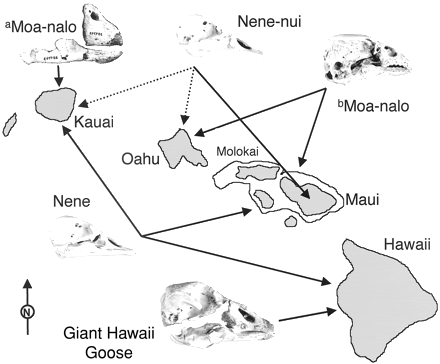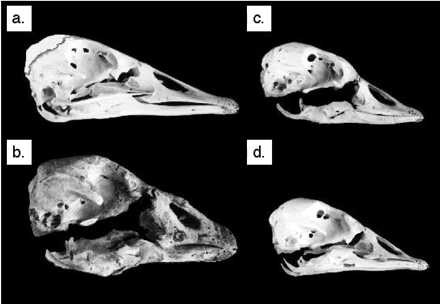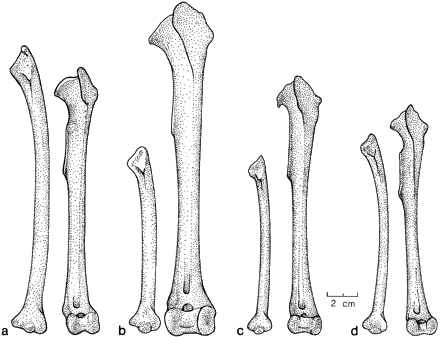|
|
Post by another specialist on Jun 6, 2005 4:38:36 GMT
Geochen rhuax
Wetmore 1943
Holocene of Hawaii, Hawaiian Islands
Primary materials: Type: Right tibiotarsus fragment
Alexander Wetmore,
An extinct goose from the island of Hawaii
The Condor 45, 4 (1943): 146-148
|
|
|
|
Post by another specialist on Nov 2, 2005 9:57:53 GMT
|
|
|
|
Post by cryptodude100 on Jun 5, 2006 12:16:24 GMT
Geochen Rhuax appears to have been about as large as the living Cape Barren Goose.
|
|
|
|
Post by dysmorodrepanis on Jun 6, 2006 8:57:39 GMT
Probably. But any details about this bird are really guesswork. Not even its relationships are identifiable. All that can be said is that it is possibly an ancestor of the moa-nalos (and just as possibly something completely different), and most likely died out before humans settled the islands.
|
|
|
|
Post by cryptodude100 on Jun 6, 2006 11:31:57 GMT
That's true. I'm just preferring to an article and a few descriptions of the bird.
|
|
|
|
Post by another specialist on Jul 27, 2007 22:53:21 GMT
Genus Geochen Wetmore, 1943 Type species: Geochen rhuax Wetmore, 1943; by monotypy and "new genus and species" convention. Includeds peciesT: ype specieso nly. Distribution: Hawaii: Kau District. Emended diagnosis:L arger and more robust than Hawaiian populations of Branta, including the robust fossil forms. Differs from Branta and from the moanalos in having the proximal articular surface of the tibiotarsus oriented lateromedially, rather than having its long axis in an antero-posterior plane, and also in having the head and trochanter of the femur more sharply set off by a groove. Differs further from the moa-nalos in having a shorter neck of the femur and a more sharply rising trochanter. Geochen rhuax Wetmore, 1943 Geochen rhuax Wetmore, 1943:146. Holotype: Very imperfect right tibiotarsus, USNM 16740. Type locality: Near Kaumaikeohu, above Pahala, Kau District, Island of Hawaii. Distribution: Known only from the type locality. Paratypes: Very fragmentary remains of right and left femora, fibula, and pelvis associated directly with the rolotype and doubtless belonging to the same individual. Remarks: This was the first fossil bird to be described from the Hawaiian Islands, the type material having been found in 1926 in the course of a public works excavation, at a depth of 25 m under a lava flow (Wetmore 1943). From their very friable and warped appearancet,h e bonesw ere almost certainlyh eatedu ntil glowing, with all organic material in the bone having been combusted. Although Wetmore (1943) considered Geochen to be more closely related to the Australian genusC ereopsisth an to Branta or other goose-likea natids, we regardt he material as being much too imperfect for determining the affinities of the bird. We can only hope that additional specimens will be found that can unambiguously be identified with the type. Otherwise, this will simply have to be regarded as a form of doubtful relationships. Storrs L. Olson & Helen F. James, Descriptions of thirty-two new species of birds from the Hawaiian Islands: Part I. Non-Passeriformes Ornithological Monographs 45 (1991) The American Ornithologists' Union, Washington D.C. elibrary.unm.edu/sora/om/om045.pdf |
|
|
|
Post by another specialist on Jul 27, 2007 22:55:30 GMT
VERY LARGE HAWAII GOOSE "Large Hawaii goose" Olson and James, 1982b:35; 1984:772. Material.' Associated fragmentary material consisting of the proximal end of a right ulna, posterior portion of a sacrum and other pelvic fragments, a vertebra, 9 pedal phalanges, and other unidentified scraps, USNM 389448-389469. Incomplete cranium lacking most of the right sidea nd basioccipital B, PBM158620; fragment of proximale nd of right femur, BPBM 158621. Six uncataloged lots of various very poorly preserved bones, probably representing six individuals. Distribution: Hawaii: westerns ide of the island. The first specimens were from two lava tubes in the vicinity of Kailua, North Kona District. The uncataloged lots are from a lava tube on Kahua Ranch, North Kohala District, at an elevation of about 1,133 m. Measurements(m m): Cranium: approximate width at nasofrontal hinge, 30. Tibiotarsus length from proximal articular surface2, 05. Tarsometatarsu length, ca. 110. Remarks:There are scarcely any comparable elements among theses amples of fragment arbyone, but all the material comes from a very large goose larger than any of the moa-nalos or the various forms of Branta, so we assume that they represent one and the same species The wing was reduced, but not nearly to the extent as in the moa-nalos. Storrs L. Olson & Helen F. James, Descriptions of thirty-two new species of birds from the Hawaiian Islands: Part I. Non-Passeriformes Ornithological Monographs 45 (1991) The American Ornithologists' Union, Washington D.C. elibrary.unm.edu/sora/om/om045.pdf |
|
|
|
Post by another specialist on Jul 27, 2007 23:21:17 GMT
 Fig. 1. A map of the main Hawaiian Islands with skulls of two moa-nalos (a, Chelychelynechen quassus; b, Thambetochen chauliodous) and the three Hawaiian geese evaluated in this study [B. sandvicensis (nene), B. hylobadistes (nene-nui), and the undescribed giant Hawaii goose]. Fossils of the giant Hawaii goose have been found only on the island of Hawaii (1, 2). Moa-nalos were found only on the older islands from Maui to Kauai (1). Arrows show that the nene, B. sandvicensis, and nene-like (B. hylobadistes and relatives) geese were widely distributed among the main islands. |
|
|
|
Post by another specialist on Jul 27, 2007 23:23:24 GMT
 Fig. 2. Skulls and mandibles in lateral view. (a) B. canadensis maxima (USNM 555497); (b) giant Hawaii goose (BPBM 179440); (c) B. hylobadistes (BPBM PPBH7); (d) B. sandvicensis (USNM 557998). The length of the giant Hawaii goose skull (b) is 127.6 mm.  Fig. 3. Left ulna and tibiotarsus. (a) B. canadensis maxima (USNM 555497); (b) giant Hawaii goose (BPBM 179440); (c) B. hylobadistes (BPBM PPBH7); (d) B. sandvicensis (USNM 557998). |
|
|
|
Post by another specialist on Oct 2, 2007 17:01:26 GMT
 Illustration by Julian Hume In the foreground is the nene, or Hawaiian goose (Branta sandvicensis). The Nene-nui, or greater nene (Branta hylobadistes), is at center and the Giant Hawaii goose (an undescribed species) is at the back. The nene is an endangered species; the other two species are extinct and known only from fossils. All three evolved in the Hawaiian Islands from an ancestor much like the modern Canada goose. This species was described from bones found at Barbers Point, Oahu. It is similar to the new species, Branta hylobadistes which was described from fossils found at Auwahi cave on Maui.The scientific name means woods-walker in Greek , a reference to this species former abundance in forested areas and its dependence on foot power because of its reduced flight capabilities. It was larger and more robust then the Nene, Branta sandvicensis. Please do what you can to save the native Hawaiian forest bird species that remain. Aloha, Michael Walther |
|
|
|
Post by cryptodude100 on Oct 9, 2007 1:08:10 GMT
What is known about the linear dimensions of the Large Hawaii goose compared to the Canada Goose or Nene?
|
|
|
|
Post by another specialist on Oct 9, 2007 7:13:25 GMT
What is known about the linear dimensions of the Large Hawaii goose compared to the Canada Goose or Nene? If you look and read post 3 and 4 you can see the comparisions of skull and leg bones plus a drwaing based on this measurements. |
|
|
|
Post by sordes on Oct 9, 2007 18:10:36 GMT
And if he had read the article, he would know that this bird was a bit over 8kg in average.
|
|
|
|
Post by another specialist on Oct 10, 2007 6:44:20 GMT
And if he had read the article, he would know that this bird was a bit over 8kg in average. Thanks Sordes I forgot to mention the article |
|
|
|
Post by cryptodude100 on Oct 15, 2007 15:34:44 GMT
Does anyone how tall the bird was in life?
|
|
Deleted
Deleted Member
Posts: 0
|
Post by Deleted on Oct 25, 2007 18:38:29 GMT
What is known about the linear dimensions of the Large Hawaii goose compared to the Canada Goose or Nene? If you look and read post 3 and 4 you can see the comparisions of skull and leg bones plus a drwaing based on this measurements. If You just take a look on this picture You may see three birds, one is the Nene (the bird in front), the largest is the large hawaiian bird without a name. If You now just find out how large the Nene is, You can very, very easily find out how large the Giant Hawaiian Goose once was, namely about 1 m (at the head). The bird in the middle is the Nene nui (Branta hylobadistes), and perhaps You can now just estimate by Yourself how large this bird once was, right ? *off topic* Did the others of You ever heard of trolls ? ? ? Think about that question for a while ! Thank You ! |
|
|
|
Post by Carlos on Oct 25, 2007 22:33:08 GMT
Never heard of trolls in real life, but I'm glad to hear of you here again, Alex.
|
|
|
|
Post by cryptodude100 on Oct 29, 2007 23:17:55 GMT
thanks
|
|
|
|
Post by another specialist on Jul 27, 2008 20:28:02 GMT
|
|
|
|
Post by Melanie on Jul 12, 2013 21:58:35 GMT
Geochen rhuax has been redescribed as Branta rhuax Olson 2013. Hawaii's first fossil bird: history, geological age, and taxonomic status of the extinct goose Geochen rhuax Wetmore (Aves: Anatidae). P Biol Soc Wash 126(2): 161–168. www.bioone.org/doi/abs/10.2988/0006-324X-126.2.161 |
|